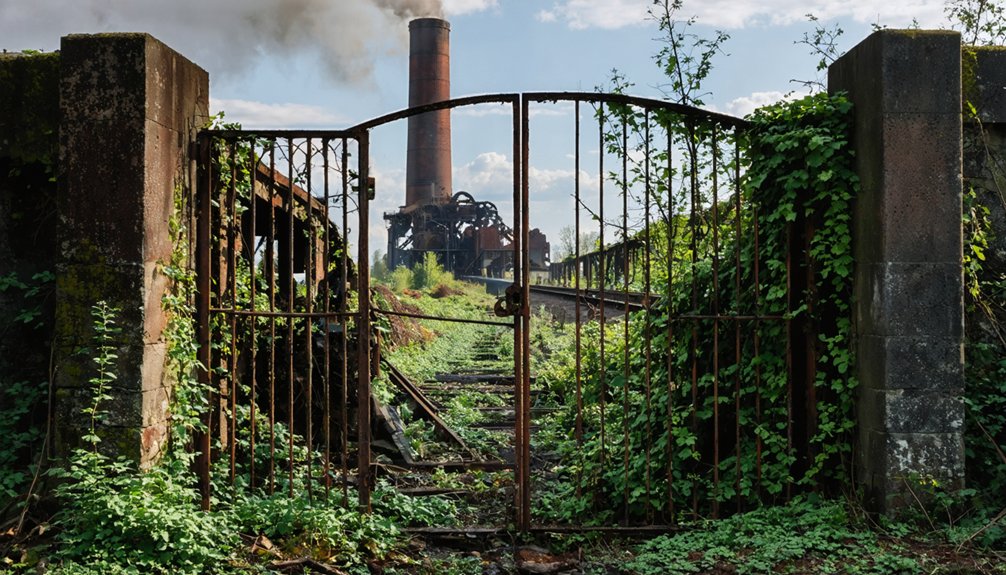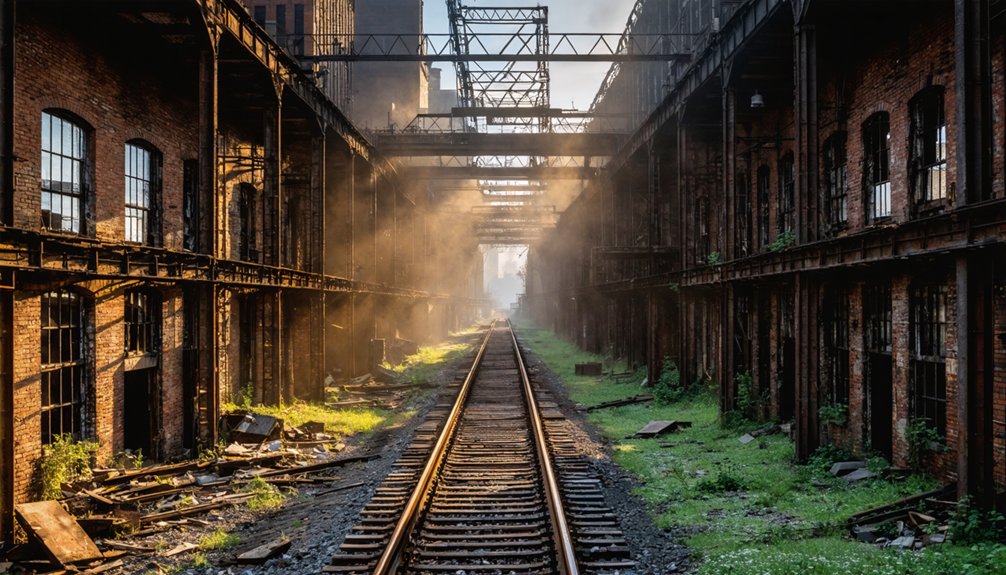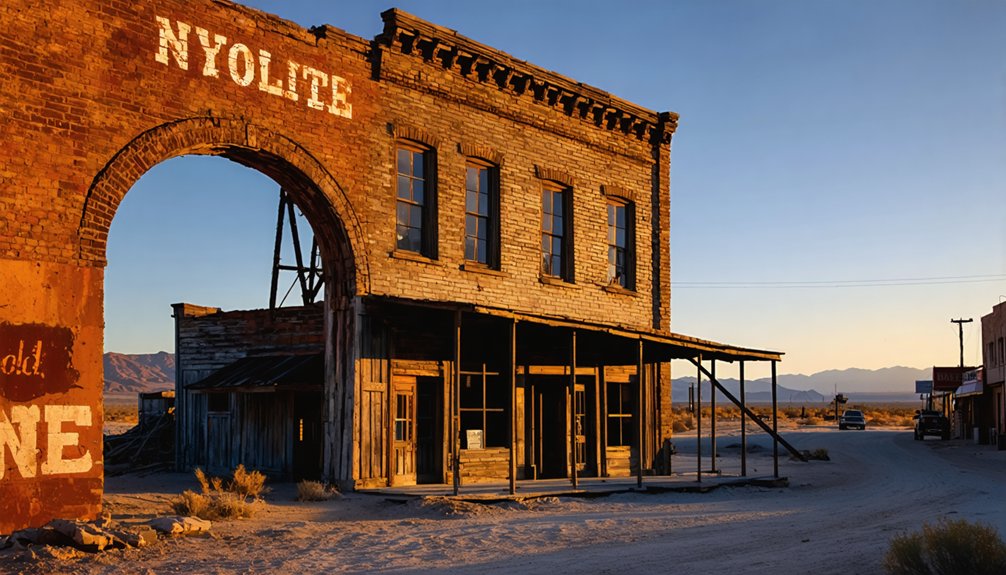America’s most fascinating abandoned steel mill towns include Bethlehem (PA), where SteelStacks transformed into a cultural venue; Johnstown (PA), facing significant economic challenges since the 1980s; Joliet (IL), now a 52-acre outdoor museum; Mineville (NY), where forests reclaim Republic Steel’s ruins; Muncie (IN), once a glass manufacturing powerhouse; Pittsburgh’s Monongahela Valley, which built the Golden Gate Bridge; and Gary (IN), the fallen “City of the Century.” These industrial ghosts tell America’s manufacturing story.
Key Takeaways
- Bethlehem, Pennsylvania transformed its shuttered Bethlehem Steel plant into the SteelStacks arts complex and National Museum of Industrial History.
- Johnstown, Pennsylvania preserves the Cambria Ironworks National Historic Landmark despite significant population decline following steel industry collapse.
- Joliet, Illinois converted its abandoned iron works into a 52-acre outdoor museum with interpretive trails highlighting industrial heritage.
- Gary, Indiana, once U.S. Steel’s “City of the Century,” features haunting industrial ruins including massive steel complexes along Lake Michigan.
- Pittsburgh’s Monongahela Valley showcases industrial decline through sites like Carrie Blast Furnaces and the steel towns of Braddock and Homestead.
Bethlehem, Pennsylvania: The Legacy of America’s Industrial Giant
Standing as a tribute to America’s industrial might, Bethlehem, Pennsylvania, once housed the sprawling operations of Bethlehem Steel, the nation’s second-largest steel producer from 1916 to 1984.
The five-mile complex along the Lehigh River employed up to 31,000 workers at its peak, crafting structural steel for icons like the Empire State Building and Golden Gate Bridge.
At its zenith, Bethlehem Steel’s massive riverside operation built America’s skylines, forging the steel backbone of a growing nation.
You’ll find one of America’s most significant industrial heritage sites here, where massive blast furnaces still tower over the landscape.
When production ceased in 1995, the community faced economic devastation, but Bethlehem exemplifies remarkable community resilience.
The former plant now houses the National Museum of Industrial History, preserving its legacy while the town reinvents itself economically.
Despite bankruptcy in 2003, Bethlehem’s story represents how industrial towns can honor their past while forging new futures.
Today, the transformed SteelStacks complex has become an arts and entertainment venue that serves as a symbol of the city’s commitment to honoring its past while embracing a cultural renaissance.
During World War II, the facility was crucial to the Allied victory, producing 70% of forgings for aircraft cylinders and significant portions of armor plating for warships.
Johnstown, Pennsylvania: A Steel Town’s Struggle and Transformation
When you visit Johnstown today, you’ll find economic devastation statistics that reveal how the once-thriving steel town lost over 30% of its population after Bethlehem Steel’s decline and closure in the 1970s-80s.
The city’s housing market collapsed as unemployment soared, resulting in over 40% of properties becoming vacant or abandoned by the early 2000s.
These abandoned properties, many still standing as deteriorating monuments to Johnstown’s industrial past, have created both preservation challenges and opportunities for redevelopment in this former steel powerhouse. Originally established as a speculative venture by Joseph Schantz in 1800 and named Conemaugh, the town’s identity has been shaped by its industrial legacy for over two centuries. Since 1989, the Cambria Ironworks site has been designated as a National Historic Landmark, representing efforts to preserve the rich industrial heritage amid the economic decline.
Economic Devastation Statistics
Though once a titan of American steel production, Johnstown, Pennsylvania exemplifies the devastating economic collapse that befell many industrial towns in the late 20th century.
The statistics tell a sobering story of economic decline: Bethlehem Steel’s workforce plummeted from 13,000 to merely 2,800 workers between the late 1970s and 1982, with over 65% of area steelworkers unemployed by the early 1980s.
The community’s resilience has been severely tested as primary metal manufacturing jobs virtually disappeared—from representing over 20% of employment in 1970 to less than 1% by 2019. For researchers and historians studying industrial decline, disambiguation pages about Johnstown provide essential pathways to accurate information about this historically significant steel town.
City revenues fell by approximately 35% during this period. Without replacement industries, and further hampered by the 1977 flood, Johnstown’s transformation efforts through tourism and small business development have struggled to offset the massive losses in traditional manufacturing employment.
Abandoned Property Crisis
The economic collapse of Johnstown’s steel industry manifested physically in the town’s landscape through a widespread abandoned property crisis that continues to challenge recovery efforts today.
When Bethlehem Steel shuttered in 1992, it left behind vast industrial complexes and adjacent worker housing that quickly fell into disrepair.
As you explore Johnstown, you’ll notice the stark urban decay particularly in neighborhoods surrounding former mill sites.
The Cambria Iron Works, while preserved as a National Historic Landmark, stands in contrast to numerous contaminated properties that hinder economic revitalization.
Environmental hazards like asbestos require costly remediation before redevelopment can occur.
The historic 1895 stone viaduct remains in use for train traffic, with its well-maintained tracks contrasting sharply against the surrounding industrial ruins.
The historic Blacksmith Shop, built in 1864, remains one of the most well-preserved structures with its octagonal ceiling and early 20th-century tools still intact.
Despite these challenges, community organizations have worked to transform select properties into cultural spaces, attempting to leverage the town’s industrial heritage while addressing the persistent blight of abandoned structures.
Joliet, Illinois: Exploring the Preserved Ruins of a Steel Empire
Walking among the preserved blast furnace remains at Joliet Iron Works Historic Site, you’ll witness the second-largest steel mill in America during its heyday, now transformed into a 52-acre outdoor museum with interpretive trails.
The iron works, which once employed 4,000 workers and produced essential railroad rails that connected the expanding nation, stands as a symbol of America’s industrial might from 1869 until operations ceased in the 1980s.
Nature now reclaims these industrial ruins, with the Des Plaines River preservation system integrating the site into a larger conservation effort that honors both the natural landscape and Joliet’s steel-making heritage. The early workforce consisted primarily of Southern and Eastern Europeans who immigrated to find new opportunities in America’s growing industrial centers. After sitting vacant for nearly a century, the site underwent a significant city cleanup in 1991 that preserved its historical importance.
Structural Preservation Efforts
While abandoned for decades, Joliet’s steel mill ruins now stand as remarkable examples of industrial preservation in America’s rust belt. The Will County Forest Preserve District’s acquisition of the 52-acre site between 1991-1997 transformed these decaying structures into an accessible historical landmark. These massive structures once produced 2,000 tons of pig iron daily during their operational years.
Despite community engagement efforts, preservation planning has faced significant challenges.
Recent preservation milestones include:
- Vegetation clearance revealing previously hidden structural foundations
- Installation of interpretive signage explaining blast furnace processes
- Development of concrete trails connecting industrial ruins to the I&M Canal
- Partial repairs to the Main Office Building in 2022
Unfortunately, preservation advocates continue battling deterioration, as evidenced by the preventable September 2024 fire that destroyed the historic Main Office Building—highlighting the urgent need for coordinated preservation strategies among stakeholders.
Historic Industrial Significance
Established in 1869 during America’s post-Civil War industrial expansion, Joliet Iron Works rapidly grew into the nation’s second-largest steel production facility, employing up to 4,000 workers during its operational zenith between 1890 and 1930.
The site’s historic industrial heritage is embodied in its Bessemer steel plant, designed by renowned engineer Alexander Holley, which became America’s ninth operating plant of its kind in 1873.
As you explore these grounds, you’ll connect with the complex workforce challenges faced by mainly Southern and Eastern European immigrants who endured extreme hazards—toxic fumes, dangerous falls, and scorching heat—to produce the steel rails that literally built America.
Their labor transformed Illinois into the world’s second-largest manufacturer of steel rails after Pennsylvania, directly enabling the expansion of America’s crucial railroad infrastructure and transportation networks.
Nature Reclaims Industry
Today’s visitors to Joliet Iron Works find a landscape that exists in striking contrast to its industrial heyday—nature has gradually reclaimed what was once a thundering hub of American steel production.
Urban exploration enthusiasts discover a post-industrial terrain where foundations of massive blast furnaces resemble ancient ruins despite their relatively recent abandonment.
The site offers compelling lessons in industrial archaeology through:
- Stone structures overtaken by persistent vegetation
- Blast furnace foundations standing like monolithic relics
- Filled underground tunnels and chambers, sealed in 2013
- Interpretive walking paths (0.59 mile) guiding visitors through factory remnants
Since the Forest Preserve District acquired the 52-acre site in the 1990s, this representation of American industry has transformed into a preserved memorial where nature steadily erases humanity’s industrial footprint.
Mineville, New York: Republic Steel’s Forest-Reclaimed Remnants

Nestled in the forests of Essex County, New York, Mineville stands as a tribute to America’s industrial heritage and nature’s reclamation power.
This once-booming iron ore center supplied 8.8% of the nation’s iron ore in 1875, with Republic Steel operating the mines from 1938 until their closure in 1971.
Before demolition in 2023, the site was an urban exploration paradise, with concrete structures and conveyor systems hidden among dense vegetation.
You could trace the shift of power from Witherbee, Sherman & Company to Republic Steel while wandering among tailings piles and abandoned mine shafts.
The Iron Center Museum now preserves Mineville’s industrial heritage in the former office building.
Like many Rust Belt communities, Mineville’s story reflects America’s changing economic landscape as forests gradually reclaim what industry once dominated.
Muncie, Indiana: The Forgotten Heartland of Manufacturing
While Mineville showcases nature’s reclamation of industrial ruins, Muncie, Indiana offers a different perspective on America’s manufacturing decline.
Once thriving on the 1886 natural gas discovery, this strategic rail hub evolved into a manufacturing powerhouse until economic shifts decimated its industrial core.
Muncie’s industrial history reveals America’s rise and fall of manufacturing:
- Ball Brothers dominated glass production, creating 74 million jars annually by 1905 before closing their plant in 1962.
- Hemingray Glass operated for 84 years until 1972, leaving only historic landmarks.
- Indiana Bridge Company (1886-1982) symbolized the steel industry’s volatile nature.
- Labor disputes, including the 1965 UAW strike, highlighted tensions preceding industrial decline.
You’ll find Muncie’s abandoned factories standing as silent reminders of the heartland’s manufacturing heritage.
Pittsburgh’s Monongahela Valley: Steel Capital’s Abandoned Corridors

In the shadow of America’s industrial might, Pittsburgh’s Monongahela Valley stands as perhaps the most iconic symbol to the rise and fall of American steel manufacturing.
You’ll find the remains of what locals once called “the hardest working river in the world” along the Monongahela River, where towns like Braddock, Homestead, and McKeesport forged America’s skylines.
These riverside communities produced the steel that built the Golden Gate Bridge and Empire State Building before suffering catastrophic collapse in the late 1970s.
By the 1980s, over 75% of the region’s steel production had vanished, leaving rusting monuments to industrial power.
Today, you can explore this Steel Heritage at sites like the Carrie Blast Furnaces and Rivers of Steel Heritage Center, where the valley’s story of unprecedented production and stunning decline remains preserved in industrial artifacts.
Gary, Indiana: U.S. Steel’s Ghost Town on Lake Michigan
Founded explicitly as a company town by U.S. Steel in 1906, Gary transformed 9,000 acres of Lake Michigan shoreline into an industrial colossus.
Once dubbed the “City of the Century,” you’ll now find America’s most profound example of urban decay as you explore its abandoned landscape.
Four must-see remnants of Gary’s industrial nostalgia:
- City Methodist Church – closed in 1975, now a crumbling Gothic cathedral
- U.S. Steel complex – once housing 12 blast furnaces that produced 25% of America’s steel
- Gary Union Station – derelict transportation hub symbolizing disconnection
- Cudahy neighborhood – abandoned worker housing amid industrial ruins
As you navigate this rust belt icon, you’ll witness how Gary’s population plummeted from 178,000 to 78,000 after steel’s decline, leaving a haunting industrial skeleton along Lake Michigan’s shore.
Frequently Asked Questions
Is It Legal to Explore Abandoned Steel Mills Without Permission?
No, urban exploration of abandoned steel mills without permission constitutes trespassing with serious legal implications. You’re violating property laws regardless of the site’s condition or apparent abandonment.
What Safety Hazards Should Explorers Be Aware of in These Sites?
You’ll encounter numerous life-threatening hazards including unstable structures with falling debris, toxic contaminants, hazardous materials exposure, drowning risks, oxygen-deficient spaces, and potentially explosive chemicals—all of which require specialized protective equipment.
When Is the Best Time of Year to Photograph Abandoned Mills?
Strike while the iron is cool. You’ll find autumn and early spring offer ideal seasonal lighting with diffused illumination, while overcast weather conditions minimize harsh contrasts, allowing textures and decay to reveal themselves authentically.
Are There Guided Tours Available at Any of These Locations?
Yes, you’ll find guided tour options at several locations, including Sloss Furnaces in Birmingham and Rivers of Steel sites in Pennsylvania, where local tour guides share industrial heritage and technical processes.
How Have Local Communities Repurposed Abandoned Mill Infrastructure?
Out of rust, gold is forged. You’ll find communities embracing adaptive reuse by transforming mills into mixed-use developments, cultural centers, and economic hubs—creating dynamic spaces that catalyze broader community revitalization and preserve industrial heritage.
References
- https://www.loveexploring.com/gallerylist/131658/abandoned-in-the-usa-92-places-left-to-rot
- https://www.youtube.com/watch?v=lEYxTPOTqkY
- https://en.wikipedia.org/wiki/List_of_company_towns_in_the_United_States
- https://en.wikipedia.org/wiki/Wikipedia:WikiProject_Ghost_towns
- https://www.atlasobscura.com/lists/abandoned-places-midwest
- https://www.abandonedamerica.us/republic-steel
- https://www.industryweek.com/talent/article/22028380/the-abandonment-of-small-cities-in-the-rust-belt
- https://www.huckmag.com/article/photos-of-americas-declining-steel-towns-in-the-70s
- https://core.ac.uk/download/29193812.pdf
- https://www.abandonedamerica.us/bethlehem-steel



